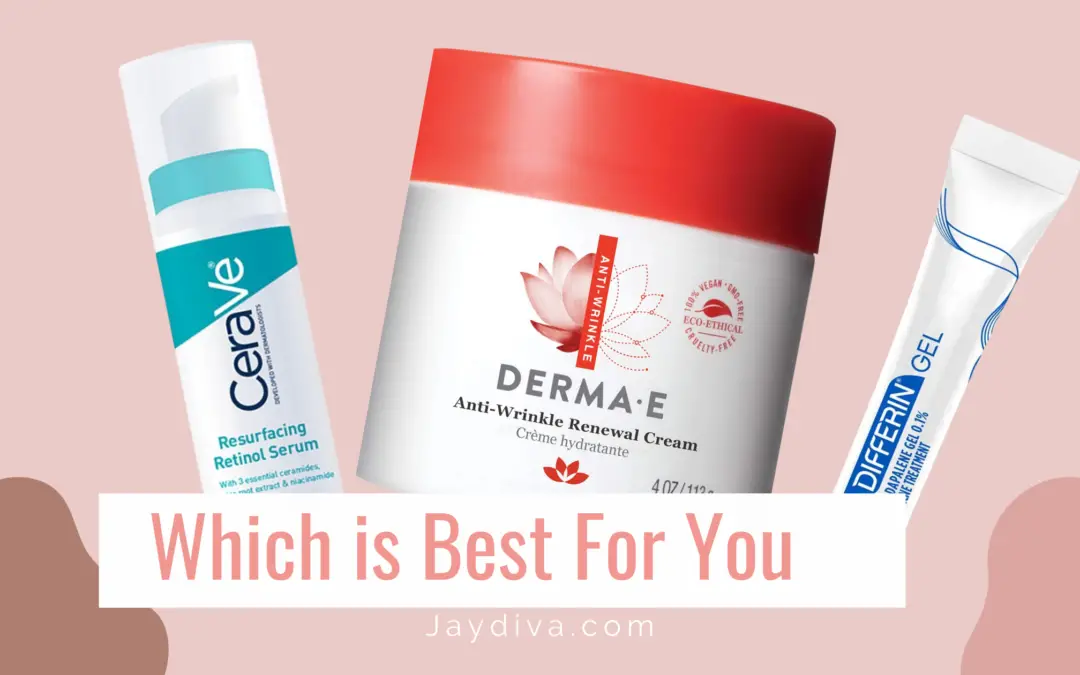A lot of us may be very familiar with the class of skincare ingredients that promises to renew our youth. they are literally “the fountain of youth”. Retinoids are a powerhouse when it comes to increasing the skin cell turnover rate, evening out skin discoloration, unclogging your pores, increasing collagen production, and evening out fine lines and wrinkles.
As a beginner, you may be overwhelmed by the decision of picking which retinoid is best for your skin, and I totally understand because Retinoids are not made equally. Picking one that isn’t suited for your skin type will only do more harm than good especially for those with sensitive skin.
This post is a beginner’s guide to helping you pick the right retinoid for you.
So grab a cup of coffee, tea, or something… and, let’s dive in
This post contains affiliate links, we earn a commission when you purchase through these links at no additional cost to you.
Would you rather watch it?
Table of Contents
How To Pick The Right Retinoid For Your Skin Concerns
Now there are so many retinoids out there from Tretinoin to retinol, retinaldehyde, retinyl palmitate, adapalene, and tazarotene these are the most common ones and amongst these tretinoin and tazarotene are prescription only in most countries while the others can be gotten over the counter.
Related Post
For the purpose of today’s post, I will be talking about over the counter retinoids
Retinyl Palmitate
This is the mildest in the family of retinoids. It is an ester of retinol and palmitate acid. When it is applied to the skin it is broken down to retinol which is then broken down to retinaldehyde and then to retinoic acid. Retinoic acid is the active form that binds to nuclear receptors and mediates all the awesome benefits of retinoids.
Due to the number of steps in its pathway, you can tell it is not as potent as its cohorts and so is best for beginners and for those with very sensitive skin.
Best Products Pick
Retinol
This is the most popular amongst its peers due to its efficacy and fewer irritations as compared to the gold standard Tretinoin. Retinol is a first-generation retinoid. On the skin, it gets converted to retinaldehyde which in turn gets converted to retinoic acid. Its fewer steps in the conversion process make it more potent and more irritating than retinyl palmitate.
So If you can’t handle tretinoin, but you don’t deal with overly sensitive skin then retinol is the way to go. These days most retinol serums are formulated with encapsulated retinol which has largely reduced the irritation associated with retinol.
It comes in 0.1 to 1 % strengths. It’s always wise to start slow with every retinoid. When starting out, stick with the 0.1-0.25% and gradually build your way up.
Retinol is a good alternate for those with acne and who are just starting their retinoid journey who eventually want to work their way up to using Tretinoin.
Best Products Pick
Related Post
Retinaldehyde
Retinaldehyde is the precursor to retinoic acid. It is also known as retinal and is more potent and more irritating than retinol as it only undergoes one conversion step to retinoic acid. It’s the next best thing to tretinoin that can be gotten over the counter. Because of the irritation associated with retinaldehyde, it may not be the first choice for people with sensitivity issues.
For beginners, you can use retinaldehyde with a lot of caution, basically the same way you would handle tretinoin. For those who are not new to retinoids who have been on retinyl palmitate or retinol, retinaldehyde can be an intermediate step before you move to tretinoin.
Best Products Pick
Adapalene
Adapalene is a third-generation retinoid specifically marketed for the treatment of mild to moderate acne. It works by preventing the formation of acne under the skin due to its ability to increase cell turnover. Hence keeping the pores unclogged. Adapalene is lipid soluble so it can easily cut through the lipid barrier of the skin into the pores to unclog them. This makes it the number one choice for acne sufferers.
In the treatment of acne, it can be used alone or in conjunction with benzoyl peroxide (epiduo forte) or the antibiotic clindamycin. Adapalene comes in over the counter strength of 0.1% and prescription-strength of 0.3%
Best Products Pick
I hope with this post you can now decide on what retinoid to use. I will see you on the next one.
Pin For Later























